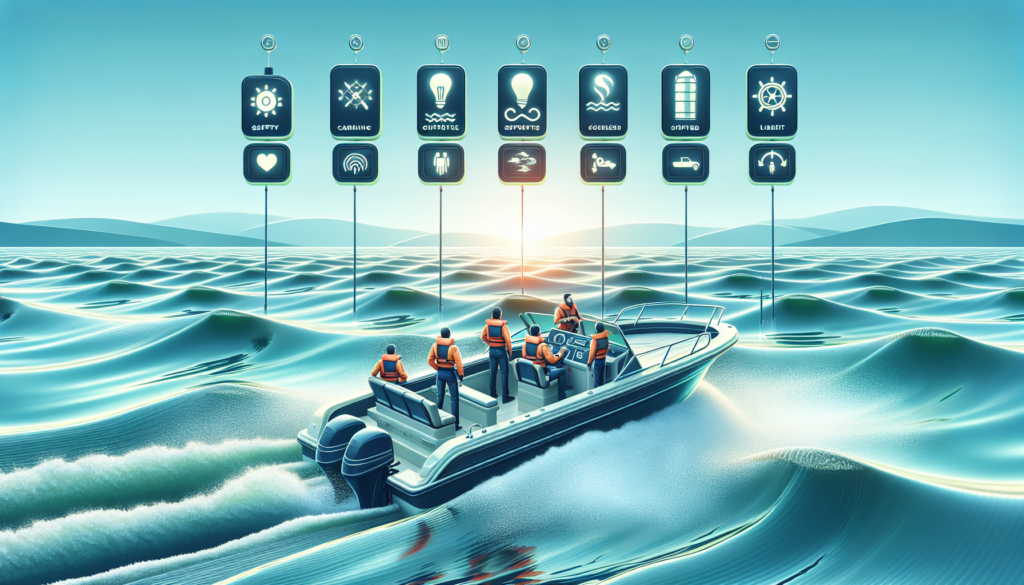You’re on sparkling water under the vivid azure sky, the wind gently rustling your hair as you steer your vessel through the tranquil sea – the very picture of perfect boating. But even in this idyllic setup, law enforcement lurks, ready to penalize any slip-ups. “Most Common Boating Violations And How To Avoid Them” is your map to navigating these legal waters, leading you safely around potential tripwires and towards a hassle-free boating experience. Boost your maritime common sense, embrace responsible conduct on the water, and keep this guide close hand – your ticket to countless carefree voyages on the ocean blue.

Failure to Have Required Safety Equipment
Boating is an adventure, a joy, and a unique way to explore the beauty of nature. But, as they say, without the right preparation, every adventure can turn into a dangerous journey. This brings to the essential yet often ignored requirement of having the right safety equipment on board.
Listing the essential safety equipment
Recommendations may vary slightly depending on your type of boat or location, but universally, there are a few items you’ll always need. They include life jackets, throwable flotation devices, fire extinguishers, sound-producing devices, visual distress signals, navigational lights, and first-aid kits. You should also have a VHF marine radio to communicate in case of an emergency.
Understanding why each item is necessary
Every item in your safety kit serves a unique purpose. Life jackets are there to keep you afloat if you end up overboard. Fire extinguishers are essential in case of a fire breakout, which can escalate quickly, especially with fuel on board. Distress signals — both sound and visual — come in handy when you need to catch the attention of other boaters or coast guards in case of an emergency situation.
Guideline to regularly check equipment
Now that you know what to pack and why, let’s talk about how regularly to perform safety checks. Ideally, you should check your safety equipment before every voyage. Pay attention to expiry dates and wear and tear. Make it a habit to replace or repair any items that seem compromised.
Overloading and Overpowering Boats
Beyond safety equipment, another critical safety concern on the water is overloading and overpowering your boat.
Understanding the weight and power capacity for boats
Every boat comes with a maximum weight or person capacity and a power rating. The boat’s capacity plate usually lists these ratings. Overloading or overpowering your boat can compromise its stability and increase the risk of capsizing.
Risks involved in overloading and overpowering
Overloading can cause your boat to sit lower in the water, which makes it less stable, less maneuverable, and more likely to capsize. Overpowering your boat threatens to put enormous strain on its structure and enhance your chances of losing control.
Tips in avoiding overloading and overpowering
Avoid exceeding your boat’s maximum weight and power capacity ratings. For weight distribution, ensure that it’s evenly spaced, keeping the boat balanced. And when adding a new motor, ensure it doesn’t exceed your boat’s power capacity.
Operating a Boat Under the Influence
Operating a boat under the influence of alcohol or drugs impacts your ability to safely navigate the waters. It’s illegal and poses significant risks.
Highlighting legal boating alcohol limits
In many areas, the legal blood alcohol limit for boating is set at 0.08 — the same as for driving a car.
Impacts of alcohol on boating skills
Alcohol under the sun can intensify its effects. It can impair your motor control, increase reaction times, induce fatigue, and reduce your ability to make sound judgments — all of which are crucial for safe boating.
Promotion of sober boating
Sober boating isn’t just the law; it’s the cornerstone of safe, enjoyable experiences on the water. Equip yourself with non-alcoholic beverages and encourage others onboard to do the same.

Not Observing Speeding Regulations
Like the rules on the road, the waterway has speed limits too. And it’s essential to abide by them.
Familiarizing with local boating speed limits
Local boating speed limits may vary depending on location and water conditions. It’s your responsibility to know these limits to ensure safety for all.
Knowing circumstances that warrant reduced speeds
Certain circumstances call for reduced speeds, such as choppy waters, reduced visibility, and high traffic areas. You should also maintain low speeds near the shore, docks, and swimmers.
Using GPS for speed management
A marine GPS can be a great tool for keeping track of your speed. In addition to navigation, these devices often display your current speed, helping you ensure you’re not exceeding the limit.
Failure to Comply With Navigation Rules
Navigation rules, or “rules of the road,” exist to prevent collisions and confusion on the water.
Understanding the right of way regulations
Right of way rules determine who has priority when two vessels cross paths. Generally, the vessel on the right gets precedence, but factors like boat type or activities can alter this.
Knowing proper signaling on waterways
Signaling on waterways involves using a combination of sound signals, like horns or bells, and visual ones, like light signals or flags. Correct use helps communicate your intentions to other boaters and facilitates safe passages.
Tips to avoid common navigation mistakes
By understanding and respecting the navigation rules, you can avoid many common mistakes. Always stay alert and avoid distractions. Use proper signaling and always have adequate lookout while on the move.
Neglecting Proper Lighting
Lighting is an essential aspect of boating, especially during nighttime or low-light conditions.
Regulations on display of boat lights
Boats are required to display specific lights from sunset to sunrise and in poor visibility conditions, such as fog or heavy rain. The type of lights and their positioning depend on your boat size and type.
Consequences of improper lighting
Improper lighting can lead to misjudgments about your vessel’s size, direction, and intention, leading to collisions and mishaps.
Routine checks for functioning lights
Ensure a routine check of all your lights before setting sail—especially if you’ll be out past dusk or in potentially low-visibility conditions.
Lack of Required Documentation
Boating requires certain documents that affirm your boat’s legality and your authority to operate it.
Essential boating documents
Vital documents include your boating license, registration, proof of insurance, and any specific permits required for the waters you plan to navigate.
Consequences of not having appropriate documentation
If you’re caught boating without these documents, you can be fined or even denied access to waterways.
Keeping documents updated and at hand
Always keep your documents up-to-date and in a waterproof bag on your vessel. It’s crucial to have them easily accessible in case of inspections.
Illegal Discharge of Trash
Responsibility towards the environment is necessary on all fronts, but particularly critical on waterways.
Understanding pollution regulations
Federal law prohibits boaters from discharging trash into the water. Anything from food wrappers to fishing line can negatively impact local wildlife and water quality.
Impact of trash on marine life & environment
Garbage in the water can harm marine life, ruin the beauty and balance of aquatic ecosystems, and affect water quality for those who rely on it for drinking or recreational activities.
Promoting green boating
Always take your trash back to the shore for proper disposal. Encourage fellow boaters to do the same and contribute to the ‘green boating’ movement.
Operating Without a Valid Boating License
Operating a boat requires adequate knowledge, skills, and responsibility. This is where a boating license comes in.
Understanding who needs a boating license
Every operator of a motorized vessel typically needs to have a boating license. License requirements may vary by age, boat length, or type of waterway.
Process of acquiring a boating license
Acquiring a boating license typically involves taking a course covering critical boating safety information and regulations, followed by a certification test.
Potential penalties for unlicensed boating
Boating without a license can result in hefty fines and possible suspension of your boating privileges.
Noncompliance With Wake Zone Regulations
Wake zones are another critical aspect to consider for safe and responsible boating.
Explaining what are wake zones
Wake zones are areas where boats must maintain minimal wake to prevent damage to docks, moored boats, and shoreline property, and to ensure the safety of swimmers and wildlife.
Potential damage and danger from improper wake
A boat’s wake can capsize small boats, erode shorelines, disturb wildlife, and even be hazardous for swimmers.
Maintaining proper speed in wake zones
In wake zones, adjust your speed to leave as little wake as possible—typically at an idle speed or slightly above.
Through these points, not only is your safety ensured while enjoying your boating voyage, but you also uphold a respectful, responsible boating etiquette for all to follow, protecting others and the environment alike. Safe and mindful boating makes the waterway a better place for everyone.

